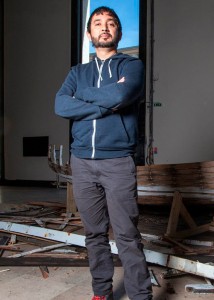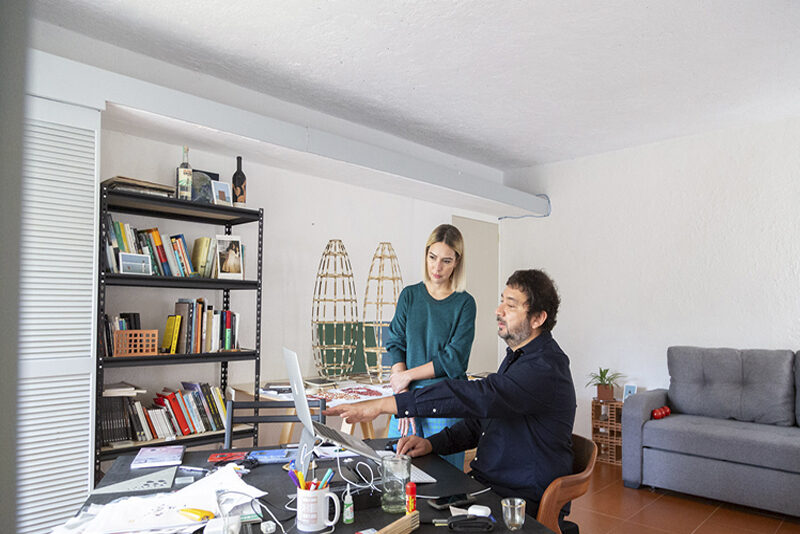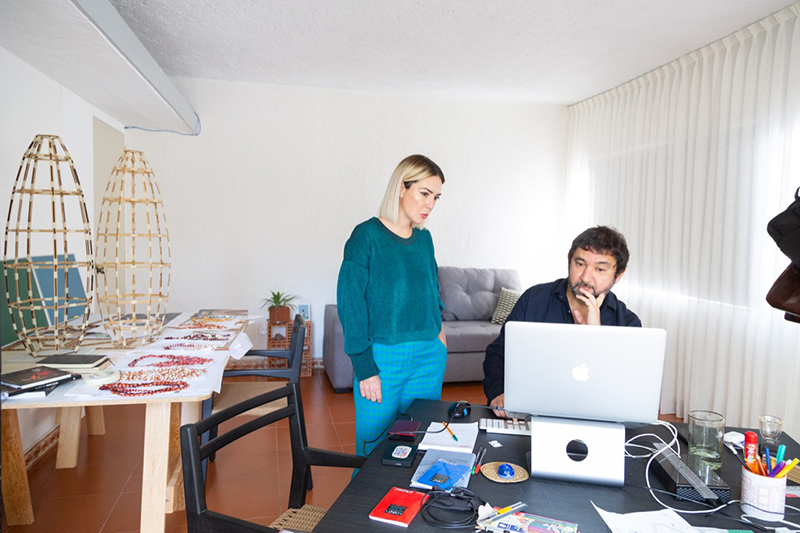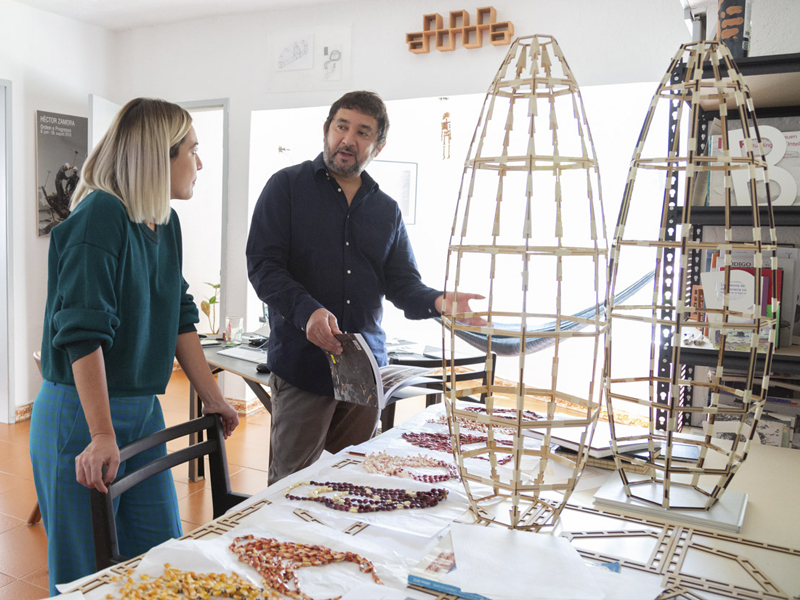Héctor Zamora
ARTIST
HÉCTOR ZAMORA (MEXICO CITY, b. 1974)
SCULPTURE, INSTALLATION

OCTOBER 2021
El arte no es inocente. Una conversación con Héctor Zamora
POR REGINA DE CON COSSÍO
Fotografías de Fernanda Segura
A lo largo de su carrera, Héctor Zamora (Ciudad de México, 1974) ha trabajado con la escultura, la instalación e incluso el performance, aprovechando sus posibilidades formales para construir, intervenir, modificar o poner en tensión los espacios que estas mismas construyen o donde son expuestas. Si bien su obra aborda temas sociales y culturales, estos se hacen presente a través de las experiencias o reflexiones que denotan el encuentro con ellas. De esta manera, sus piezas no sólo son objetos con un sentido simbólico, sino irrupciones al pensamiento y el cuerpo que trastocan -de diferentes formas- lo cotidiano.


Regina De Con Cossío: Algunas de tus piezas entablan un estrecho diálogo entre el arte y la arquitectura. Estoy tentada a preguntar cuál es la diferencia, para ti, entre una y otra disciplina, pero ahora mismo creo que se trata de la temporalidad: una pieza de arte como las tuyas dura un tiempo y desaparece. En cambio, un edificio perdura. ¿Cuál es el impacto que intentas con tus piezas? ¿Lo puedes medir de alguna manera? Si una pieza es efímera, ¿cómo puedes explicar su resonancia?
Héctor Zamora: Creo que la clave esta en la experimentación y libertad. Busco un impacto total, provocar una reacción en todo el cuerpo tanto individual como social, sacudirlos y a partir de ahí todas las relaciones que se puedan general individual y colectivamente son lo que dan forma a la obra en sí. No busco medir. La resonancia es la propia obra y es atemporal
RDCC: En algunas entrevistas que diste sobre Lattice Detour, que presentaste en el MET, mencionas que uno de los propósitos es situar al espectador ante una obra que lo obligue a reflexionar sobre el espacio. Me cuesta trabajo pensar que esta provocación es inocente. Es decir, ¿hasta qué punto un artista puede encaminar las reflexiones de un espectador? ¿Cuál es la responsabilidad moral o ética del artista en sus obras?
HZ:En principio no veo diferencia desde el lado del creador, y también la temporalidad se “perrea” en ambos lados, probablemente la arquitectura efímera como pabellones, etc., sería en donde se encuentra más libertad para experimentar fuera de los parámetros de la funcionalidad y la legalidad de las reglas que regulan el espacio construidle y habitable.
Nada es inocente en una obra, todos los símbolos tienen una función dentro de esa provocación. Lo importante es que ese lenguaje simple es plural y puede tocar a un público muy amplio, ya cada quien lo descodifica de acuerdo a lo que esos símbolos le comunican. Esas reacciones son la obra, así como todas las espontaneidades que se generan.
Responsabilidad es un término muy complejo y abierto, y mucho más en el terreno de lo público. Para mí, es lograr tirarte de tu cotidianidad dándote un respiro o sacudida que te pueda llevar a volver a mirar el mundo a detalle y con eso experimentar la vida más plenamente, o cuando es necesario recordar temas que no debemos olvidar dentro de un contexto personal y colectivo. Lo demás son reglas sociales que tú sabes hasta qué punto las puedes flexibilizar para continuar con la libertar de experimentación. Estamos en tiempos muy complejos donde muchas cosas que se daban por sentadas ya no lo son, pero al mismo tiempo no podemos autocensurarnos buscando agradar a todas las posibles opiniones y formas de vida del mundo, pero hay que estar conscientes de todo.
RDCC: ¿Cuáles te parecen que sean los cambios más importantes que hayan ocurrido en el arte?
El desastre de la presión comercial es uno de los cambios más fuertes que ha tenido el arte, lo políticamente correcto y las presiones de temas llevados a la exageración hasta por lo comercial, como lo indígena, lo negro o los temas de género. Lo bueno es la pluralidad y la mayor apertura en cuanto al origen de los artistas que, por lo menos en países como México, [ser artista] ya no es mas un privilegio de las clases acomodadas, por lo menos como era cuando yo era estudiante.
RDCC: Entre otras intenciones, tus obras ponen en tela de juicio espacios políticos y sociales. En el contexto de la pandemia, ¿pasó algo con los espacios de los museos? ¿Por qué da la impresión de que los museos no cambiaron significativamente su devenir? Salvo la posibilidad de “visitar” algunas exposiciones de manera virtual, parece que lo más interesante del arte pasó en otros espacios…
Los museos son espacios controlados, todo y nada es posible. Son cubos blancos, paredes y espacio definidos. La interacción conlleva entrar en ellos, cruzar la puerta y eso implica que quien entra es porque quiere y/o puede pagar; tiene que haber una predisposición y eso cancela la posibilidad de lo plural. ¡Y son espacios públicos! La diferencia es que afuera no hay que cruzar esa frontera y las variables y condiciones de trabajo son infinitas
RDCC:Durante la pandemia estuvimos obligados a permanecer en casa. Los espacios públicos fueron despojados de sus actividades habituales. Con el regreso a las calles en México se ha dado un fenómeno muy interesante: por un lado, algunos movimientos sociopolíticos que tenían años de estarse gestando manifestaron sus intenciones de apropiarse de los espacios públicos (como el movimiento feminista en Ciudad de México). Actualmente hubo una polémica alrededor del monumento a Colón en Reforma. ¿Cuál es tu opinión respecto de los monumentos, la administración pública y el papel de los artistas? Muchas veces los artistas esperan procedimientos institucionales para intervenir los espacios públicos. ¿Por qué no hacerlo a lo Banksy, por ejemplo?
HZ:Mi trabajo siempre ha reflexionado y hasta en algunos momentos ha estado claramente opuesto al concepto de monumento. Para mí, Bansky hace monumentos al capitalismo
HZ: Son muchos nombres…
RDCC: Tengo mucha curiosidad en preguntarte acerca de los fenómenos derivados de las criptomonedas en el mundo del arte. Siendo un artista cuyos intereses parecen estar más cerca de lo físico y lo espacial, ¿qué piensas de estos fenómenos del mercado del arte y de la relación entre el espectador y el artista que se dan a partir de los NTF’s?
HZ: Creo en lo físico y es claro en mi obra. Tal vez es generacional y no voy a renunciar a ello.


Art is not innocent. A conversation with Héctor Zamora
BY REGINA DE CON COSSÍO
Photographs by Fernanda Segura
Through his career, Héctor Zamora (Mexico City, 1974) has worked with sculpture, installation and even performance, taking advantage of their formal possibilities to build, intervene, modify or put in tension the spaces that they themselves build or where they are exposed. Although his work addresses social and cultural issues, these are made present through the experiences or reflections that denote the encounter with them. In this way, his pieces are not only objects with a symbolic meaning, but irruptions to thought and the body that disrupt -in different ways- everyday life.
Regina De Con Cossío: Some of your pieces establish a close dialogue between art and architecture. I’m tempted to ask what the difference is, for you, between one discipline and another, but right now I think it’s about temporality: a piece of art like yours lasts for a while and disappears, instead, a building endures. What is the impact you intend with your pieces? Can you measure it somehow? If a piece is ephemeral, how can you explain its resonance?
Héctor Zamora: I think the key is experimentation and freedom. I am looking for a total impact, to provoke a reaction in the entire body, both individual and social, to shake them and from there all the relationships that can be generated individually and collectively are what shape the work itself. I’m not looking to measure it. The resonance is the artwork itself and it is timeless
RDCC: In some interviews you gave about Lattice Detour, which you presented at the MET, you mention that one of the purposes is to place the viewer before a work that forces them to reflect on space. I find it hard to believe that this provocation is innocent. That is, to what extent can an artist guide the reflections of a viewer? What is the moral or ethical responsibility of the artist in his works?
HZ: In principle, I don’t see any difference from the side of the creator, and temporality is also “perrea” on both sides, probably ephemeral architecture such as pavilions, etc., would be where there is more freedom to experiment outside the parameters of the functionality and the legality of the rules that regulate the buildable and habitable space.
Nothing is innocent in a work, all the symbols have a function within that provocation. The important thing is that this simple language is plural and can touch a very wide audience, and everyone decodes it according to what these symbols communicate. Those reactions are the work, as well as all the spontaneities that are generated.
Responsibility is a very complex and open term, and much more so in the public sphere. For me, it means managing to pull yourself out of your everyday life, giving you a break or jolt that can lead you to look at the world in detail again and with that experience life more fully, or when it is necessary to remember issues that we should not forget within a personal and collective context. The rest are social rules that you know to what extent you can relax them to continue with the freedom of experimentation. We are in very complex times where many things that were taken for granted are no longer, but at the same time we cannot censor ourselves seeking to please all possible opinions and ways of life in the world, but we must be aware of everything.
RDCC: What do you think are the most important changes that have occurred in art?
HZ: The disaster of commercial pressure is one of the strongest changes that art has had, what is politically correct and the pressures of issues that have been exaggerated even by commercial issues, such as indigenous, black or gender issues. The good thing is the plurality and the greater openness regarding the origin of artists that, at least in countries like Mexico, being an artist is no longer a privilege of the wealthy classes, at least as it was when I was a student
RDCC: Among other intentions, your works question political and social spaces. In the context of the pandemic, did something happen to the museum spaces? Why do you get the impression that museums have not significantly changed their future? Except for the possibility of “visiting” some exhibitions virtually, it seems that the most interesting art happened in other spaces…
HZ: Museums are controlled spaces, everything and nothing is possible. They are white cubes with defined walls and space. The interaction entails entering them, crossing the door and that implies that whoever enters is because they want to and/or can pay; there has to be a predisposition and that cancels the possibility of plurality. And they are public spaces! The difference is that outside there is no need to cross that border and the variables and working conditions are infinite
RDCC: During the pandemic we were forced to stay at home. Public spaces were stripped of their usual activities. With the return to the streets in Mexico, a very interesting phenomenon has occurred: on the one hand, some sociopolitical movements that had been brewing for years have expressed their intentions to appropriate public spaces (such as the feminist movement in Mexico City). Currently there is a controversy around the monument to Columbus in Reforma. What is your opinion regarding monuments, public administration and the role of artists? Artists often wait for institutional procedures to intervene in public spaces. Why not do it like Banksy, for example?
HZ: My work has always reflected and even in some moments has been clearly opposed to the concept of monument. For me, Banksy makes monuments to capitalism.
HZ: There are many names…
RDCC: I am very curious to ask you about the phenomena derived from cryptocurrencies in the art world. Being an artist whose interests seem to be closer to the physical and the spatial, what do you think of these phenomena of the art market and the relationship between the viewer and the artist that arise from the NTFs?
HZ: I believe in the physical and it is clear in my work. Maybe it’s generational and I’m not going to give it up.


